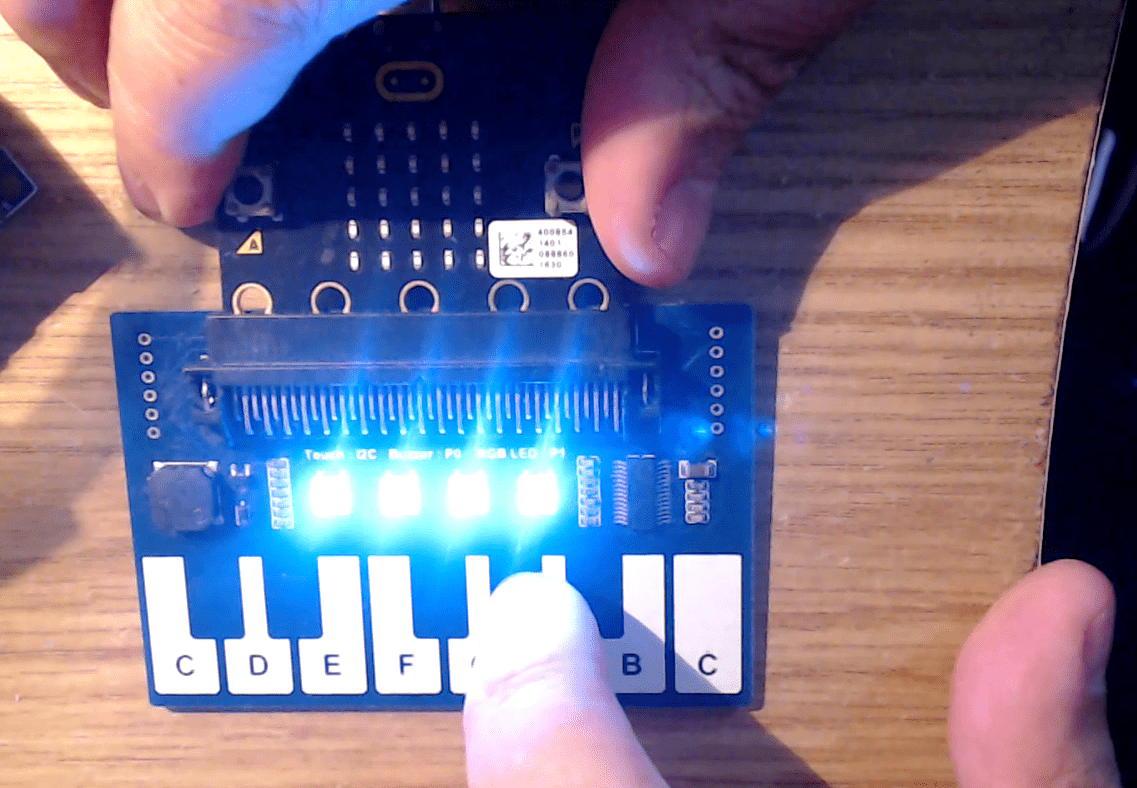In this article we look at a Mini Piano Module that you can connect to your micro:bit.
The module uses a TTP229 which has 13 touch keys connected to it through an I2C interface, the board also has 4 WS2812B RGB LEDs fitted to it which can display 16777216 colors. There is also a buzzer fitted to the board which can play a note depending on whatever key you press.
In the following image you can see me using the module

microbit piano
Parts List
The piano module costs about $17, so you can get this and a micro:bit for under $40. Here are a couple of links to the products
Pinout
The module connects through an edge connector and uses the following pins
| micro:bit pins | DESCRIPTION |
|---|---|
| VCC | 3.3V input |
| GND | Ground |
| P0 | Buzzer control pin |
| P1 | LED control pin |
| SCL | Touch keys control pin, I2C clock |
| SDA | Touch keys control pin, I2C data |
Code
The waveshare wiki has some code example and instructions on using the Block editor but here is a python example based on a user code example.
Copy this into the micro:bit python editor at https://python.microbit.org/v/1.1 , now click on download and drag the hex file to the drive that was created on your PC when your micro:bit was plugged in, the hex file will be programmed into your micro:bit and you should have a working mini piano
[codesyntax lang=”python”]
# Add your Python code here. E.g.
from microbit import *
import neopixel
import music
from random import randint
rgb = neopixel.NeoPixel(pin1, 4)
class PIANO():
def __init__(self):
#The piano key corresponds to the touch screen value.
self.Zero = 0x0000
self.C = 0x0001
self.bD = 0x0002
self.D = 0x0004
self.bE = 0x0008
self.E = 0x0010
self.F = 0x0020
self.bG = 0x0040
self.G = 0x0080
self.bA = 0x0100
self.A = 0x0200
self.bB = 0x0400
self.B = 0x0800
self.C1 = 0x1000
self.play = self.Zero
def TouchPress(self):
try:
arr = i2c.read(0x57, 2)
val = arr[0] + arr[1] * 256
except OSError:
val = 0xffff
return val
def ShowRGB(self,RGB):
for rgb_id in range(0, 4):
rgb[rgb_id] = (RGB[rgb_id][0], RGB[rgb_id][1], RGB[rgb_id][2])
rgb.show()
def Color(self):
red = randint(0, 30)
green = randint(0, 30)
blue = randint(0, 30)
for rgb_id in range(0, 4):
rgb[rgb_id] = (red, green, blue)
return rgb
def PlayPiano(self):
TPval = self.TouchPress()
if TPval & self.play != 0:
TPval = TPval & self.play
elif TPval == self.C:
self.ShowRGB(self.Color())
music.pitch(262, wait=False)
elif TPval == self.bD:
self.ShowRGB(self.Color())
music.pitch(277, wait=False)
elif TPval == self.D:
self.ShowRGB(self.Color())
music.pitch(294, wait=False)
elif TPval == self.bE:
self.ShowRGB(self.Color())
music.pitch(311, wait=False)
elif TPval == self.E:
self.ShowRGB(self.Color())
music.pitch(330, wait=False)
elif TPval == self.F:
self.ShowRGB(self.Color())
music.pitch(349, wait=False)
elif TPval == self.bG:
self.ShowRGB(self.Color())
music.pitch(370, wait=False)
elif TPval == self.G:
self.ShowRGB(self.Color())
music.pitch(392, wait=False)
elif TPval == self.bA:
self.ShowRGB(self.Color())
music.pitch(415, wait=False)
elif TPval == self.A:
self.ShowRGB(self.Color())
music.pitch(440, wait=False)
elif TPval == self.bB:
self.ShowRGB(self.Color())
music.pitch(466, wait=False)
elif TPval == self.B:
self.ShowRGB(self.Color())
music.pitch(494, wait=False)
elif TPval == self.C1:
self.ShowRGB(self.Color())
music.pitch(523, wait=False)
elif TPval == self.Zero:
rgb.clear()
music.stop()
if TPval != 0xffff:
self.play = TPval
Piano = PIANO()
while True:
Piano.PlayPiano()
[/codesyntax]
The code is also available from https://github.com/getelectronics/Microbitlearning
Video Usage
Here you can see me testing the piano module, this is using the code example above
Links
User manual – https://www.waveshare.com/w/upload/a/a4/Piano_for_microbit_User_Manual_EN.pdf
